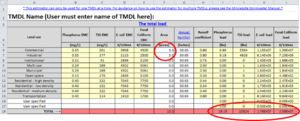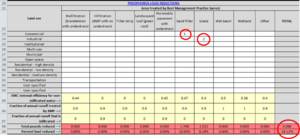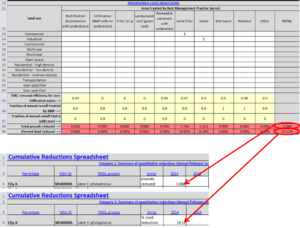
Difference between revisions of "Quick Guide: MPCA Estimator tab"
m |
m |
||
| Line 1: | Line 1: | ||
| + | <div style="float:right"> | ||
| + | <table class="infobox" style="border:3px; border-style:solid; border-color:#FF0000; text-align: right; width: 300px; font-size: 100%"> | ||
| + | <tr> | ||
| + | <th><center><font size=3>'''Overview of the MPCA Simple Estimator'''</font size></center></th> | ||
| + | </tr> | ||
| + | <tr> | ||
| + | <td>'''The MPCA Simple estimator is an Excel-based tool that utilizes the [https://stormwater.pca.state.mn.us/index.php?title=The_Simple_Method_for_estimating_phosphorus_export Simple Method] to estimate total suspended solid and/or total phosphorus loads and load reductions associated with implementation of best management practices (BMPs). The spreadsheet includes the following features.''' | ||
| + | *Up to 10 worksheets where the user provides inputs to estimate loading. Each worksheet includes the following. | ||
| + | **Multiple land uses | ||
| + | **Adjustable event mean concentrations, runoff coefficients, pollutant removal efficiency, and percent of runoff treated by a BMP | ||
| + | **Adjustments in loading associated with non-structural BMPs, such as street sweeping and changes in land use | ||
| + | *A worksheet summarizing pollutant loads and reductions across the ten worksheets described above. | ||
| + | *An information sheet with links to useful pages in the stormwater manual | ||
| + | *A notes sheet where users can provide additional information | ||
| + | *A blank worksheet where usaers can make calculations or store data | ||
| + | </td> | ||
| + | </tr> | ||
| + | </table> | ||
| + | </div> | ||
| + | |||
{{alert|This page has been updated to reflect Version 3.0 of the Estimator|alert-info}} | {{alert|This page has been updated to reflect Version 3.0 of the Estimator|alert-info}} | ||
| − | + | This page provides a quick guide to using the Estimator. For detailed guidance, [http://stormwater.pca.state.mn.us/index.php/Guidance_and_examples_for_using_the_MPCA_Estimator Link to full guidance on the Estimator]. | |
| − | + | The MPCA estimator worksheet presents an easy-to-use calculator to compute the pollutant load reduction for total phosphorus (TP) and total suspended solids (TSS). Results from the estimator can be used in the Cumulative reductions tab of the <span title="the amount of a pollutant from both point and nonpoint sources that a waterbody can receive and still meet water quality standards"> [https://stormwater.pca.state.mn.us/index.php?title=Total_Maximum_Daily_Loads_(TMDLs) '''total maximum daily load''']</span> (TMDL) Annual Report form. | |
| − | [http://stormwater.pca.state.mn.us/index.php/Guidance_and_examples_for_using_the_MPCA_Estimator Link to full guidance on the Estimator] | + | Useful links |
| + | *Download updated MPCA Estimator here: [[File:MPCA simple estimator version 3.0.xlsx]] | ||
| + | *[http://stormwater.pca.state.mn.us/index.php/Guidance_for_completing_the_TMDL_reporting_form Link to full guidance on the TMDL Form] | ||
| + | *[http://stormwater.pca.state.mn.us/index.php/Guidance_and_examples_for_using_the_MPCA_Estimator Link to full guidance on the Estimator] | ||
| + | *[[Recommendations and guidance for utilizing the MPCA Simple Estimator to meet TMDL permit requirements]] | ||
| + | *[[Case study for using the MPCA Simple Estimator to meet TMDL permit requirements]] | ||
| − | + | ==Gather BMP information== | |
| + | STEP 1: Define the boundaries of your area. | ||
| + | {{alert|If you are using the Estimator for TMDL compliance, it can only be used for one TMDL at a time. Separate spreadsheets must be created for each TMDL.|alert-info}} | ||
| − | = | + | STEP 2: Identify <span title="a stationary and permanent BMP that is designed, constructed and operated to prevent or reduce the discharge of pollutants in stormwater"> '''structural'''</span> and <span title="Stormwater practices that are not permanent, physical devices or structures but that reduce pollutant loading. Examples include street sweeping, pollution prevention, education, impervious surface disconnection, and illicit discharge disconnection."> '''non-structural'''</span> <span title="one of many different structural or non–structural methods used to treat runoff"> '''best management practices'''</span> (BMPs) and identify other activities that affect pollutant loading (e.g. changes in land use). |
| − | |||
| − | |||
| − | |||
| − | ==Input data to | + | ==Input data to Estimator== |
STEP 3. Enter the TMDL Name in Row 2. This name will match a TMDL name from the ''BMP-Activities Completed tab''. | STEP 3. Enter the TMDL Name in Row 2. This name will match a TMDL name from the ''BMP-Activities Completed tab''. | ||
<br /> | <br /> | ||
Revision as of 15:08, 28 March 2020
The MPCA Simple estimator is an Excel-based tool that utilizes the Simple Method to estimate total suspended solid and/or total phosphorus loads and load reductions associated with implementation of best management practices (BMPs). The spreadsheet includes the following features.
|
This page provides a quick guide to using the Estimator. For detailed guidance, Link to full guidance on the Estimator.
The MPCA estimator worksheet presents an easy-to-use calculator to compute the pollutant load reduction for total phosphorus (TP) and total suspended solids (TSS). Results from the estimator can be used in the Cumulative reductions tab of the total maximum daily load (TMDL) Annual Report form.
Useful links
- Download updated MPCA Estimator here: File:MPCA simple estimator version 3.0.xlsx
- Link to full guidance on the TMDL Form
- Link to full guidance on the Estimator
- Recommendations and guidance for utilizing the MPCA Simple Estimator to meet TMDL permit requirements
- Case study for using the MPCA Simple Estimator to meet TMDL permit requirements
Gather BMP information
STEP 1: Define the boundaries of your area.
STEP 2: Identify structural and non-structural best management practices (BMPs) and identify other activities that affect pollutant loading (e.g. changes in land use).
Input data to Estimator
STEP 3. Enter the TMDL Name in Row 2. This name will match a TMDL name from the BMP-Activities Completed tab.
STEP 4. Calculate the acreage for each applicable land use within the TMDL watershed (Column F, rows 6 through 17). Note default acreage of 0.001 is entered for each land use, since an acreage of 0 leads to calculation errors.
STEP 5. Determine the Annual Rainfall (Column G, rows 6 through 17). The default is 30.65 inches.
STEP 6. Determine if the default Event Mean Concentration (EMC) is appropriate for your situation (Columns B through E; rows 6 through 17).
Once acreages are entered for land uses, a total load is auto-calculated for the pollutant of concern. In the example below, this TMDL has 5 acres of commercial land and 5 acres of industrial land. Default values for rainfall and EMC are being used. Total loading is 16.15 lbs of TP, 10524 lbs of TSS, 1.76e7 EC organisms, and 2.03e7 FC organisms.
STEP 7. Choose the calculator that matches the pollutant for the TMDL you chose. The screenshot below shows the appropriate calculator for a Phosphorus TMDL. Enter the acreage treated by each BMP type for each appropriate land use within the appropriate reductions calculator. The acreage is a cumulative acreage for all BMPs of the same type.
Once acreages are entered, total pounds (for TP in this example) and percent load reduced are auto-calculated. In the example below, the permittee operates three acres of sand filters (could be multiple sand filters totaling 3 acres) in commercial areas and two acres of swales (could be multiple swales totaling 2 acres) in industrial areas. The total pounds of TP reduced are 3.088 and the total TP reduced is 19.12 percent. As a check, the worksheet will generate an error message if the acreages entered exceed total land use acreage.
STEP 8. Input the calculated reductions (choose pounds reduced or percent load reduced) to Category 1 in the Cumulative Reductions tab for that reporting year and TMDL.


